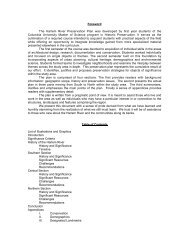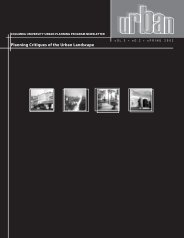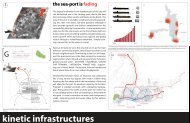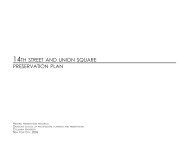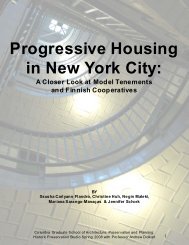The Art of Planning - Columbia University Graduate School of ...
The Art of Planning - Columbia University Graduate School of ...
The Art of Planning - Columbia University Graduate School of ...
You also want an ePaper? Increase the reach of your titles
YUMPU automatically turns print PDFs into web optimized ePapers that Google loves.
AGENDA IN TWO HOURS OR LESS<br />
8<br />
6) …and more equitable. In the tax code’s<br />
relationship with housing, the big issue is the federal<br />
homeowner tax deduction (and the deduction <strong>of</strong><br />
property taxes on income taxes.) If this subsidy on<br />
owner-occupied housing is to remain, it should be<br />
extended to renter-occupied housing: about a third<br />
<strong>of</strong> U.S. residents live in rentals, and they should<br />
have the same federal income tax deduction that<br />
homeowners are given. Or we could scrap the<br />
deduction altogether, and instead establish a<br />
deduction based on the percent <strong>of</strong> one’s income<br />
spent on housing.<br />
7) Finally, fund intercity rail planning separately<br />
from Amtrak, and tie it to airport and transit planning. Airport operators can make excellent<br />
rail transit planners because they have an incentive to build rail, both for increased<br />
connection to airports for long flights, and for relief from short flights within a mega-region.<br />
Transit agencies have an obvious interest in rail to other cities, and if it’s going to work,<br />
intercity rail will need the kinds <strong>of</strong> connections it has in the Northeast, where “direct to<br />
downtown” means a connection to transit service.<br />
Part II: <strong>The</strong> Transportation Bill –“TEA time is over!”<br />
decision-making about infrastructure and the environment<br />
directly into the federal funding process, as the Metropolitan<br />
<strong>Planning</strong> Organization (MPO) system intended. All local and<br />
regional project funding should be based primarily on requests<br />
from local and regional elected <strong>of</strong>ficials, not on earmarks by<br />
Congressional representatives; <strong>of</strong>ficials <strong>of</strong> each region would<br />
have to agree on funding priorities before asking Congress<br />
for funding. This would provide some incentive to form real<br />
regional governance structures, and would require regional<br />
concurrence on major infrastructure investments.<br />
<strong>The</strong> new transportation bill – needed by the end <strong>of</strong> 2008 but<br />
probably postponed until the 2010 fiscal year – is a twice-adecade<br />
opportunity to address infrastructure and Photograph courtesy <strong>of</strong> Matthew Roe<br />
development<br />
at a national level. Transportation funding in the new bill should encourage much more<br />
regional control and radically better incentives for making sustainable decisions. Regions<br />
must gradually be made more important in transportation planning than state and<br />
local boundaries, and these regions must be able to set basic land use goals for their<br />
subsidiaries. Just as the “farm bill” should be reconsidered as a comprehensive rural<br />
policy bill, so too should the transportation bill be rethought <strong>of</strong> as an urban policy bill, land<br />
use included. (I can see the acronym now: the Department <strong>of</strong> Transportation, Housing,<br />
and Urban Development, or THUD.)<br />
Despite its love <strong>of</strong> unfunded mandates, Congress has been far too shy to use its massive<br />
project funding (read: the transportation bill) as a carrot to direct local governments. But<br />
national coordination has been accomplished in the past on such issues as speed limits<br />
and drunk driving through what amounts to strings attached to highway funding. Why not<br />
tie transportation funding to sustainable, equitable land use practices? Besides, I dare<br />
you to find a development whose materials and labor are entirely sourced from within<br />
one state. (Constitutionality Alert: regional planning issues obviously involve interstate<br />
commerce and interstate commuting.)<br />
A fair and goal-oriented national system <strong>of</strong> transportation project finance must be created<br />
to replace the existing earmark-reliant method <strong>of</strong> Federal funding, which greatly distorts<br />
both national priorities and national wealth distribution. This system should build regional<br />
How might these goals be built into a transportation bill? All localities desiring capital<br />
finance in a given period (maybe two years) could be required to submit a capital budget<br />
and a realistic development plan encompassing physical and human elements, broader,<br />
more open-ended, and subject to more review than a typical “comprehensive plan”. This<br />
plan would be submitted to a regional planning body, akin to a regional MPO but composed<br />
<strong>of</strong> the chief executives and top legislators <strong>of</strong> each locality in the region, not heads <strong>of</strong><br />
planning agencies. Agreement at this regional council would be necessary for all federally<br />
financed capital expenditures in the region, not just expenditures on the planning process<br />
itself as is the case today. Thus, localities would be given the ability to determine the best<br />
solution to all local planning issues as they do now, but would be required to accomplish<br />
certain goals. Most importantly, they would be required to meet mandates built into the<br />
Bill - primarily for sustainable and equitable policies.<br />
URBAN



